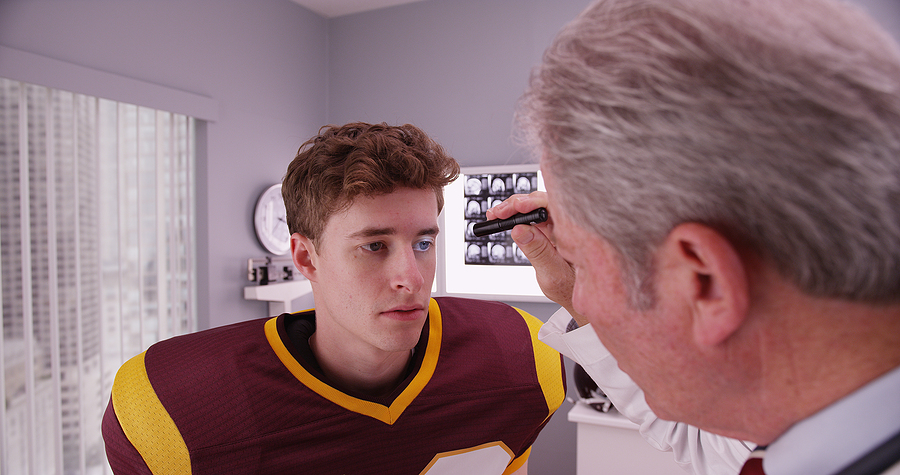Concussions are not one of the more serious grades of a traumatic brain injury, but that doesn’t make them something to ignore. If you play Fresno sports or have a child participating in team or group sports, concussion awareness is essential.
Even a potential concussion isn’t something to ignore. In 2011, a Scottish teen took a blow to the head, but he went back on the field. A second and a third hit to the head occurred, and each time he went back to play. He ended up collapsing and dying at the hospital in what doctors called “Second Impact Syndrome.”
Following his death, Irishrugby.ie created a downloadable pocket guide to concussions. Any head injury could cause traumatic brain injuries that shouldn’t be ignored. You need to know how to recognize the signs of a concussion and what to do if you suspect someone took a hard blow to the head.
Concussion Facts to Keep in Mind
A concussion is a type of traumatic brain injury. It occurs when a fall or blow to the head causes the brain to shift suddenly and hit against the skull, which causes injury and can damage brain cells.
It’s on the mild end of the spectrum, but just because it’s mild, it isn’t something to ignore. A concussion can become serious and requires medical attention. Here are some facts about concussions.
- 3.9% of U.S. kids have been diagnosed with a concussion or TBI.
- 5% of soccer players experience TBIs
- 10% of all athletes playing a contact sport suffer at least one concussion each year.
- Basketball, cheerleading, football, and soccer are four of the most common sports that send children ages 6 or older to the hospital.
- If you break down the rates of concussions in 2020 and separate the kids, 2% of concussions happened in children 5 or younger, 5.8% were in ages 6 to 11, and 12.2% were in ages 12 to 17.
- Most sports-related injuries happen in practices, but concussions are the one exception and usually happen during a game.
- Once an athlete has one concussion, the likelihood of a second concussion is 4x to 6x greater.
- Upwards of 3.8 million athletes suffer at least one concussion each year.
Perhaps most alarming is that people with TBIs have a high rate of committing suicide. It’s better to be seen and have it ruled out than take the chance.
Recognize the Signs of a Concussion
SCAT5 is a tool designed by professionals, but it shares pointers that can help anyone. There is an Adult SCAT5 and a Child SCAT4, and both are available online, but they’re not easy for a layperson to use.
Some of the components of SCAT5 that are worth memorizing help you identify and assess the risk of a concussion. After a head injury, watch for these signs and look for red flags.
Know the Signs of a Concussion
The signs of a concussion that you can see include:
- A blank stare
- Confusion and disorientation
- Difficulties with balance and gait
- Facial injuries
- Lack of coordination with motor skills
- One pupil is larger than the other
- Speech is slurred
Watch for the Red Flags You Cannot Ignore
You should ask the person about these red flags and seek immediate care if they answer yes to any of them or if you know the answer is yes to any of them.
- Are you experiencing double vision?
- Are you feeling more tired than usual?
- Can the person answer simple questions like where they are, what year it is, or who’s the president?
- Did the person pass out?
- Do you feel any tingling or weakness in your arms or legs?
- Do you feel sick?
- Do you have a headache?
- Does your neck hurt?
Again, get to a Fresno doctor immediately if there’s the smallest chance of a concussion.
How Are Concussions Treated?
There’s no magical cure for a concussion. It takes time and rest. A full night’s sleep and naps and rest breaks during the day are essential. You do have to give up sports for a few weeks while your brain recovers.
When you go to an urgent care or hospital, the doctor will assess the brain injury using the SCAT5 assessment tool. If the injury seems severe, brain scans may be necessary. Otherwise, most patients go home with someone to watch them for a couple of days. A person who has a concussion should not be alone.
For the next couple of days, a person with a concussion must be monitored for signs of worsening brain injuries. Once this period passes, it’s possible to get back to a more normal routine, but anything strenuous on the brain, such as sports practices, exams, or studying for a big test, is best avoided for now. It can take months to recover from a brain injury, and it’s not a process to rush.
If you (the athlete) or your child athlete feels left out, attend practices but stay on the bench for the practice. Cheer teammates on without risking another head injury. The coach may offer a job like scorekeeping to help you feel involved.
When three months pass and the symptoms like dizziness, headaches, and concentration continue, it can be a sign of post-concussion syndrome. There’s not a lot that you can do for post-concussion syndrome except keep taking it easy and wait for your brain to heal.
If the condition is impacting your mood, medications or counseling help keep depression or anxiety from worsening. It also helps to work with a sports and orthopedic specialist to slowly work on pain management techniques and keeping the body fit without risking another brain injury.
Premium Sports & Orthopedics offers a range of non-invasive treatment options for pain relief and overall fitness. After a concussion, work with the orthopedic and sports injury treatment team to have a doctor-advised plan that makes the transition from rest and low activity to a point where you’re ready to practice and get back out on the field or court.
With a Fresno doctor’s guidance, you’ll build muscle and strength slowly. You lower the risk of reinjury and learn effective ways to manage the headaches you’re experiencing. It’s a smart way to recover from a concussion.
Book an online appointment with Premium Sports & Orthopedics online or by phone. The only scheduler is convenient as you can find the right date and time with your calendar in front of you to ensure you’re available at the time you choose.







